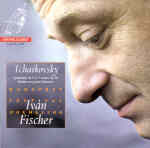In a brief booklet note conductor Ivan Fischer writes that “Tchaikovsky’s heroes are led, guided, and torn apart by intense, unavoidable forces and feelings. And yet, there is dignity, style, and even elegance.” Much of what makes this Tchaikovsky Fourth so successful is just that all-too-rare (in performance) juxtaposition of unbridled intensity and controlled elegance. Fischer’s opening “Fate” motif is drenched in rhetorical, doom-laden grandeur, and the Budapest strings lovingly caress the gentle dream dance that follows, making of it a ghostly waltz in the ballrooms of the mind. Fischer and his band project such obsessive mood-shifts, so typical of Tchaikovsky’s late symphonies, with precisely observed accuracy; the transitional links connecting them are seamlessly rendered.
It helps that Fischer keeps things moving throughout–no lingering, no “loving to death” such beauties as the gorgeous slow-movement canzona, here beautifully sung by the oboe and gracefully followed by the warm Budapest strings. Fischer’s near-perfect pacing carries over to a Scherzo fast enough to keep the string pizzicatos from becoming tiresome, yet expansive enough to lend the woodwind-led Trio the lively piquant rusticity it needs without scanting detail. Nor does the final Allegro con fuoco, with its attention-grabbing opening and roof-raising coda, lack any of the fire it needs to register its powerful impact. The orchestral execution is on par with Fischer’s interpretation, the strings radiant, the winds superb as a group and outstanding in their important solo turns, the full ensemble impressing with the solidity of its tonal resources, whether in hushed pianissimos or overwhelming climaxes.
All of these virtues carry over to the substantial filler, the Romeo and Juliet Fantasy Overture, where Fischer’s relatively brisk (but never too fast) pacing and his ability to balance clear-eyed scrubbing of sentimentality with an avoidance of excessive bombast make it a winning performance. Here again, the orchestra scores with beautifully balanced winds in the chorale-like theme and a gorgeous English horn solo and ardent strings in the love theme. Heard via the CD layer of this hybrid disc (and with the editor’s caveat noted below), the sonics are outstanding, with wide-ranging dynamics and realistic tonal balances and soundstaging. These core-repertoire works have had many splendid performances on recordings; this disc ranks among the very best.
[Editor’s Note: There is a slight mid-range pulsation in the right channel, very intermittently audible in all formats when played at high volume levels. On many systems this will probably remain below the ambient noise level of the listening room. The label confirms that this is indeed a technical glitch on the master tape that could not be corrected in final editing. Given the excellence of the performances and basic sound overall, with which I fully concur, we do not see this as a major issue, though because this is an audiophile product and Channel Classics had the all-too-rare decency to advise us of the problem, we decided to post this additional notice.–David Hurwitz] [2/17/2005]
































